#loyset liédet
Text

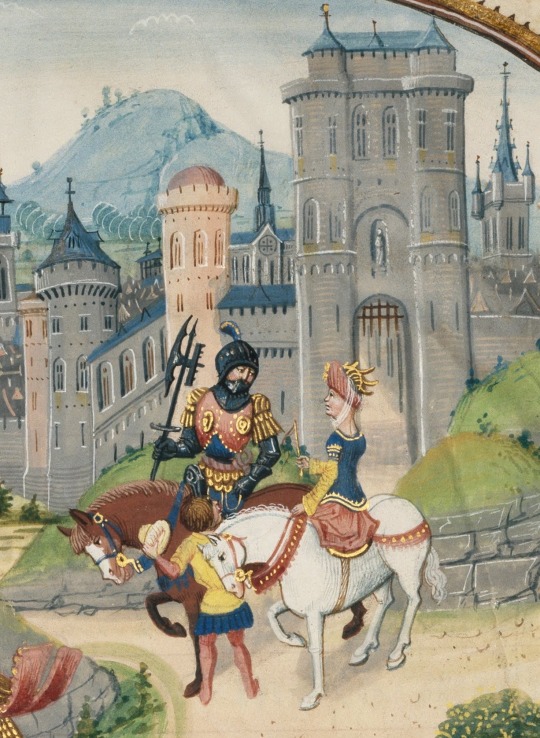
The Abduction of Ydoire
by Loyset Liédet
#art#medieval#loyset liédet#flemish#europe#european#history#knight#ydoire#knights#middle ages#landscape#armour#castle#illuminated manuscript#manuscript#damsel#damsels#histoire de charles martel#burgundian#burgundy#france#brussels#bruges#christian#adventure#charles martel#david aubert
213 notes
·
View notes
Text

The Whore of Babylon Dresses the Part, by Loyset Liédet and his workshop. Epistolary and Apocalypse of Charles the Bold, Flemish, ca. 1470
17 notes
·
View notes
Text
The Lioness of Brittany
This lady from Brittany lived from 1300-1359 and her real name was Jeanne-Louise de Belleville de Clisson Dame de Montaigu. She was a noblewoman from Brittany who, as heir to her family, took over the estates and the salt trade, and later a Pirate.
She married for the first time at the age of 12, the 19-year-old Geoffrey de Châteaubriant VIII, who died in 1326, and had her first two children with him at 14 and 16. After his death, in 1328, Jeanne married Guy de Penthièvre of the House of Penthièvre, widower of Joan of Avaugour and son of the Duke of Brittany, for the protection of her children. The union was short-lived, as relatives of the ducal family, particularly from the de Blois faction, complained to the bishops of Vannes and Rennes to protect their inheritance, and an investigation was held on 10 February 1330, leading to the annulment of the marriage by Pope John XXII. Then, in the same year 1330, Olivier IV de Clisson married a very wealthy Breton. They had five children together: Maurice, Guillaume, Olivier, Isabeau († 1343) and Jeanne. In 1342, Olivier, joined the Duke of Brittany Charles de Blois in the Breton War of Succession defending Brittany against the English claimants and the forces of English sympathizer John de Montfort.
During the ensuing campaign, Olivier came under suspicion and criticism from Charles de Blois for failing to hold Vannes against the English forces so Clisson defected to the English side. January 1343, the Truce of Malestroit was signed between England and France and under the perceived safe condition of this truce Olivier and fifteen other Breton lords were invited to a tournament on French soil. He was arrested and beheaded for treason against the king. His head was sent to Nantes, where it was presented on a spit on the battlements of Bouffray Castle near Nantes. His widow, Jeanne, swore revenge on the king and Charles de Blois, who had happily supported the death sentence.

A painting of Jeanne in a mock 15th century style, part of a composition by Elsa Millet. (x)
Her revenge consisted of selling her possessions and buying a ship. Dismayed by the death of her liege lord, she quickly found a crew of 400 men and together they hunted down French merchant ships. After several successful battles, including two attacks on two castles, her ship was badly damaged and she had to flee. She found protection and support in England and from King Edward. He and Breton sympathisers gave her money and she was able to buy several war cogs, which she had painted black and fitted with red sails, the flagship was named My Revenge. Because of this appearance, the fleet received the name Black Fleet. The ships of this Black Fleet are said to have first attacked ships in the Bay of Biscay, but then advanced into the English Channel to hunt down French merchant ships, killing entire crews and leaving only a few witnesses to carry the news to the French king. This earned Jeanne the nickname "The Lioness of Brittany" or in French “La Tigresse bretonne” (The breton tigress).
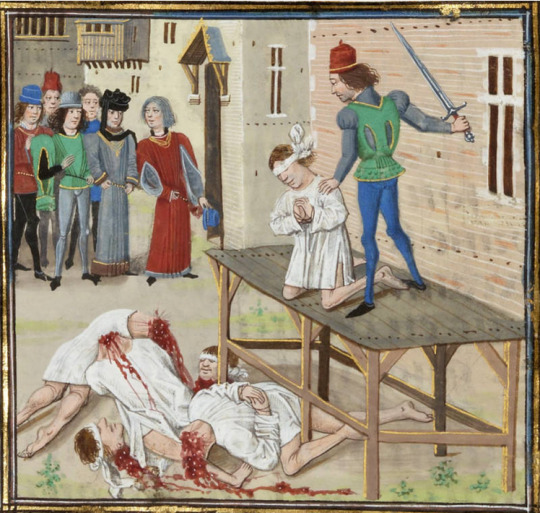
Execution of Olivier IV de Clisson. Painting attributed to Loyset Liédet, Flemish illuminator (v.1420-v.1483) in the Chronicles of Lord Jehan Froissart. (x)
She is sometimes referred to in literature as a privateer of the English, which would imply that she was subject to certain protections and obligations, but there was no known letter of marque.
In 1346, during the Crécy campaign in northern France, Jeanne used her ships to supply the English forces.
In the process, the French eventually succeeded in attacking her fleet and sinking her flagship. Jeanne and her two sons drifted at sea for five days; her son Guillaume died from the effects of the cold. Jeanne and Olivier were eventually rescued and taken to Morlaix. But this did not stop their revenge, on the contrary Jeanne continued her piracy in the Channel for another 13 years.
She probably ended her revenge in 1356, but by 1850 she had married the English nobleman, Walter Bentley, lieutenant to King Edward III until 1353 and captain of the English troops who continued to fight Charles de Blois. For his services and inheritance, both had received lands and castles in Brittany, which they were to relinquish in 1353 in order to finally achieve peace Charles de Blois. Bentley refused and was imprisoned in the Tower of London. Jeanne, tired of fighting, gave up and handed over the lands they had wanted. He was then released and in January 1357, the barony of La Roche-Moisan was granted to them. Toward the end of her life, she returned to France and has lived in Hennebont castle until the end of her life in 1359.
#naval history#female pirate#jeanne de belleville#the lioness of brittany#14th century#medieval seafaring
81 notes
·
View notes
Photo

De ridder-magiër Malegijs, op de rug van het Ros Beiaard.
Illustratie van de hand van Loyset Liédet (Brugge, 1462-1470).
2 notes
·
View notes
Photo

Loyset Liédet and his workshop - The Whore of Babylon Dresses the Part - ca. 1470
Babylon the Great, commonly known as the Whore of Babylon, refers to both a symbolic female figure and place of evil mentioned in the Book of Revelation in the Bible. Her full title is stated in Revelation 17 (verse 5) as Mystery, Babylon the Great, the Mother of Prostitutes and Abominations of the Earth.
The Whore is associated with the Beast of Revelation by connection with an equally evil kingdom. The word "Whore" can also be translated metaphorically as "Idolatress". The Whore's apocalyptic downfall is prophesied to take place in the hands of the image of the beast with seven heads and ten horns. There is much speculation within Christian eschatology on what the Whore and beast symbolize as well as the possible implications for contemporary interpretations.
Loyset Liédet (1420 – after 1479, or after 1484), was an early Netherlandish miniaturist and illuminator, running a workshop which may have been of some size. Although he was very successful, and patronized by the leading collectors of his day, his work does not attain the standards of his finest Flemish contemporaries, with whom he often collaborated on large commissions.
78 notes
·
View notes
Photo
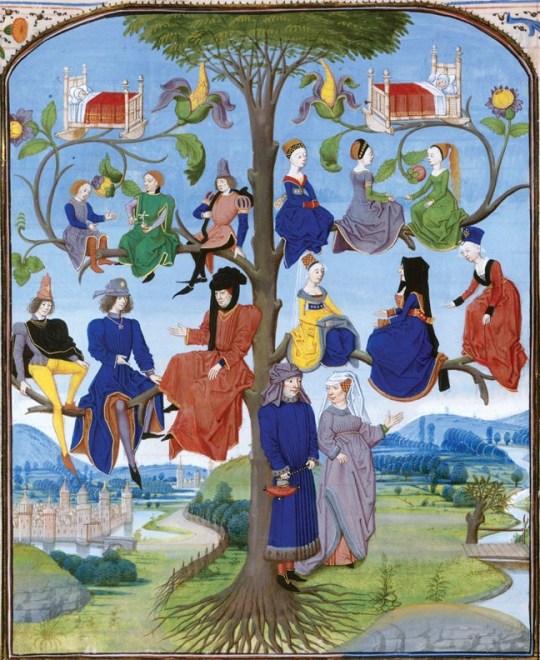
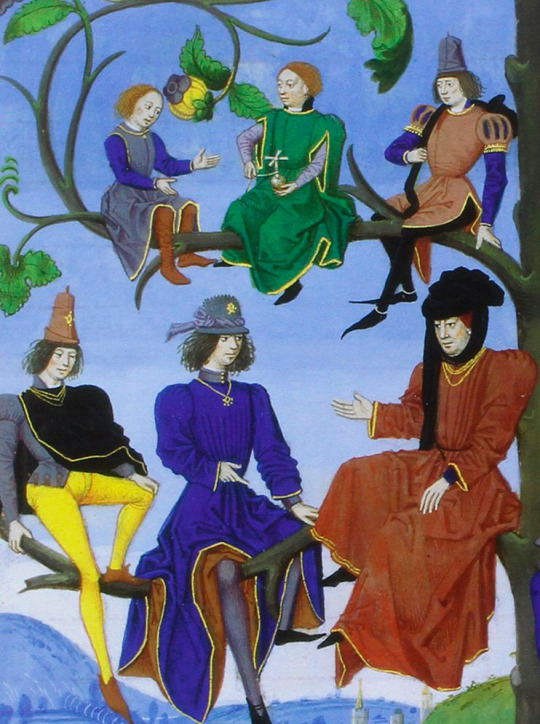
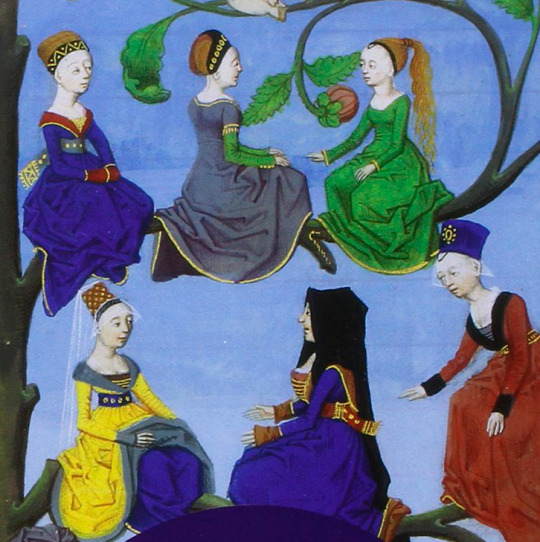
1471 Loyset Liédet - Tree of Consanguinity, page from a manuscript “Somme rurale” by Jean Boutillier
(Bibliothèque Nationale de France / François-Mitterrand Library)
507 notes
·
View notes
Photo
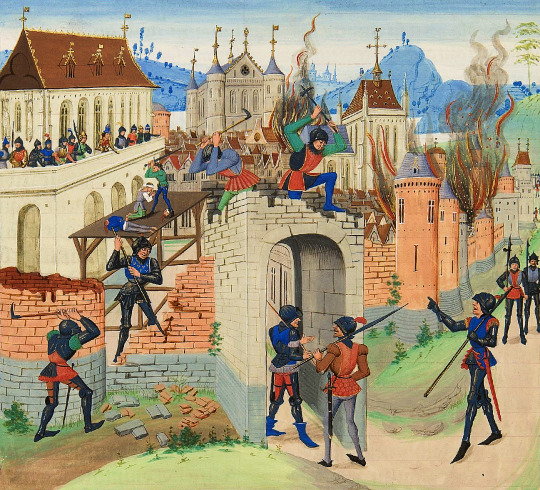
Chaos, fire, death and revenge against the vanquished in the Chroniques de Hainaut. Loyset Liédet (miniaturiste) ~ ca.1453 Bruxelles • via Bibliothèque Infernale on FB
96 notes
·
View notes
Photo
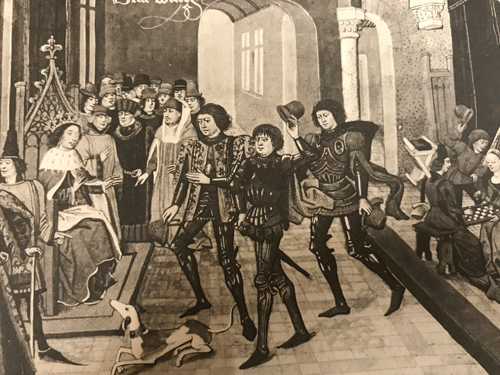
Bibliothèque Royale de Belgique, Histoire de Charles Martel, reproduction des 102 miniatures de Loyset Liédet (1470), 1910.
GIFed by @uispeccoll (source).
21 notes
·
View notes
Photo

Loyset Liédet, Pol Fruit, and David Aubert, Fifteen Cuttings from Histoire de Charles Martel, 1463-72 (Belgian). Tempera colors, gold leaf, gold paint, and ink on parchment. The J. Paul Getty Museum, Los Angeles.
3 notes
·
View notes
Photo
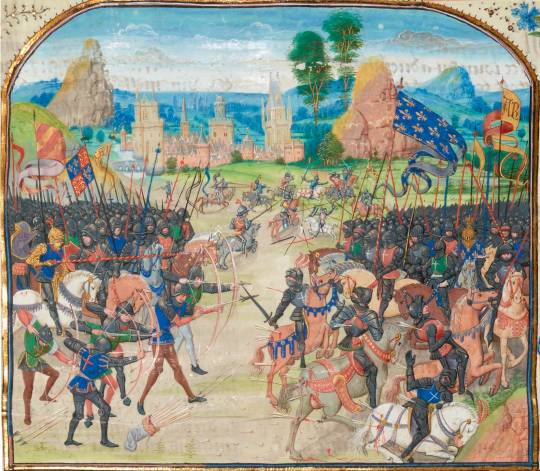
Battle of Poitiers 1356 (miniature by Loyset Liédet) posted by Reddit User: MaximusFrank Visit artofreddit.com for more art #battlepaintings
0 notes
Photo
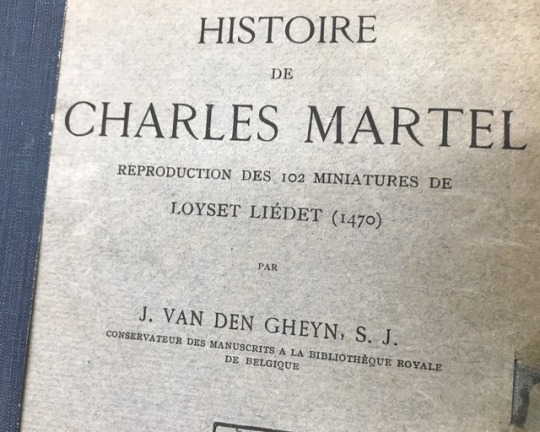
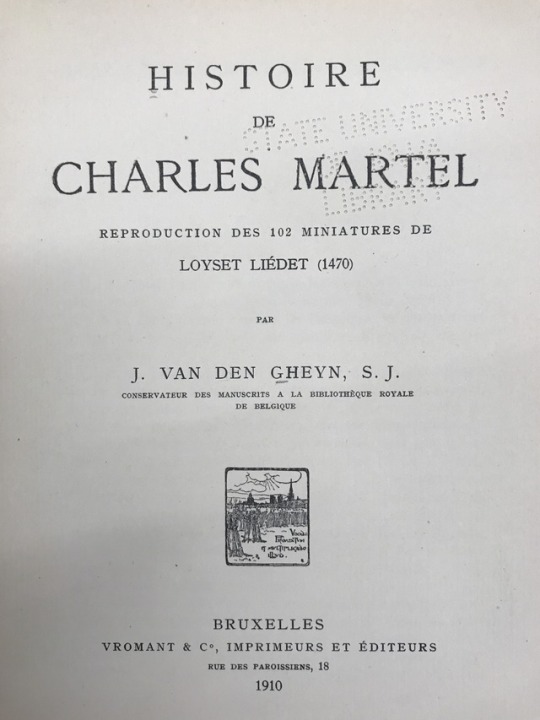


This book, Histoire de Charles Martel, contains reproductions of miniatures from the original romance “Histoire de Charles Martel et de ses successeurs” complied by David Aubert and published by Bruxelles, Vromant & Co. in 1910.
Charles “The Hammer” Martel was the mayor of the palace of Austrasia of the Frankish realm, a confederation of West Germanic peoples, from 715 to 741. He was the illigetimate son of Pippin II of Herstal, and came to power after the assassination of Pippin’s only surviving legitimate son in 714. Martel was most known for reuniting the Frankish realm and began the Muslim invasion at Poitiers in 732.
These miniature reproductions depict 120 different medieval scenes from over the course of Martel’s rule.

-Hannah
X-Collection ND3399 .C4 L5
Liédet, Gheyn, Gheyn, Joseph van den, & Brussels . Bibliothèque Royale de Belgique. (1910). Histoire de Charles Martel, reproduction des 102 miniatures de Loyset Liédet (1470). Bruxelles: Vromant &.
57 notes
·
View notes
Text
Research project - interiors

Brothel Scene (c.1658-1659) by Frans van Mieris the Elder
Sources: https://www.mauritshuis.nl/en/explore/the-collection/artworks/brothel-scene-860/detailgegevens/
http://www.essentialvermeer.com/dutch-painters/dutch_art/subject_matter.html
https://www.britannica.com/biography/Frans-van-Mieris-the-Elder
The main themes of Dutch interior paintings are those of love and the virtues of domestic life and the theme of love appears in a wide variety of ways, from romantic scenes of lovers separated by distance to scenes in brothels or of sexual love treated with a frankness that is also found in Dutch literature of the period.
The theme of seduction does not necessarily imply a financial transaction, but a sexual relationship is certainly often implicit. In many of these paintings we see wine and musical instruments. In fact, alcohol is present in such quantities in scenes of seduction that it seems to have been normally associated with the subject of love. There is a instrument and a tankard hung in this painting in the top left from the wall.
In this painting, a soldier is having his glass topped up by the barmaid and with his other hand, he tries to pull her closer. The glances they exchange and her open cleavage lead us to believe that this is a brothel.
We can also see a pair of mating dogs in the background and through an open door the couple appears to have an armorous relationship. These are the clues that lead us to believe we are viewing a brothel and even without the title of this painting, knowing the date it was painted and observing the subjects’ relationships with the environment, we could probably still easily work it out.
Mieris was a chief member of a family of Leiden (a Dutch city) painters. He painted on relatively small pannels often no bigger than 12-15 inches and he characteristically painted with a shiny brightness and metallic polish. His best painted subjects were those in which he illustrated the habits or actions of the wealthier classes although he sometimes painted homely incidents with portraiture and included allegory.

Old Woman at Prayer (1656) by Nicolaes Maes
Sources: http://www.essentialvermeer.com/dutch-painters/dutch_art/subject_matter.html
https://beautyofbaroque.wordpress.com/2015/07/11/old-woman-at-prayer-by-nicolaes-maes-1656/
In this painting we are taken to the home of what would appear to be an average Dutch woman. There is no sense of any extravagance and so we assume she is a member of the merchant class and not someone very wealthy at the time of this portrait. The work speaks of simplicity and humility.
Maes most frequently depicted this type of subject, the intention was almost always exemplary; these were representations of virtuous behavior which remind us that homes were not just physician places but also the centre of society's moral instruction.
The protagonists of most of these scenes are women of all ages who, by being located in the home, occupy the place which society considered appropriate to them, and behaved according to the models set out for each age and social situation.
It is suggested that this woman may be a widow as she has prepared her food and eats alone, the only other subject in the picture being her cat in the bottom right corner who sees the perfect opportunity to pinch something.
This type of painting reflected the profound transformations which were taking place in society. The rapid commercialization of daily life, one of the most notable features of 17th-century Holland, meant that the large number of paintings dedicated to this social space and whose quiet, meditative qualities markedly separated them from the exterior world, provided their owners with a certain degree of calm which enabled them to deal more confidently with the major changes that were affecting their lives and the resultant anxiety.
Some of the objects in this painting include a key which may indicate that the ‘key’ to a long and happy life is simple living, an open book possibly meaning there are no secrets here as she prays and an hourglass whose sand has run out potentially hinting at the woman’s old age.
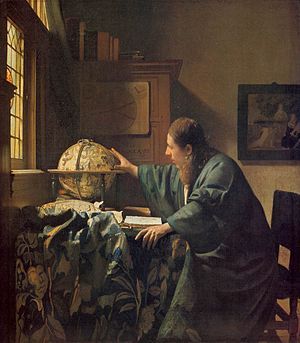
The Astronomer (1668) by Johannes Vermeer
Sources: https://vermeer0708.wordpress.com/about/
https://www.theguardian.com/artanddesign/2017/feb/21/vermeer-and-the-masters-of-genre-painting-review-louvre-paris
Portrayals of scientists were a favourite topic in 17th century Dutch paintings and this painting is believed to be coupled with and features the same subject as in Vermeer’s other painting The Geographer. He is believed to possibly be the scientist Van Leeuwenhoek who invented the microscope and was born the same year as Vermeer.
This globe in this painting presents different and complex constellations and reflects the 17th century human fascination for astronomy and science.
This painting harmonizes space, colour, and light to convey a single human activity, a unified moment in time. The composition is not narrative but rather forms the context of a sole figure, frozen in a pose of profound preoccupation.
Vermeer often painted women as his main subjects and it is only in these two paintings that men are depicted as they were believed to be the founders of science as was appropriate.
Like in this painting, Vermeer often places his subjects beside a window and the light illuminates his face to reveal his youthfulness, insight and anticipation.
His hands are also expressive and having them placed over the globe may suggest that he is exploring and opening up the eyes of people to a new and undiscovered world.
He is surrounded by books and academic illustrations which suggests that this academic has dedicated his life to learning and furthering the development of science.
source: https://www.britannica.com/art/genre-painting
Genre painting is the painting of scenes from every day life and ordinary people in work and recreation generally depicted in a realistic way. The scenes that are painted are quite intimate in content as they are painted within interiors and give us an insight into the life of the Dutch painters who created the work and the people around them. It is generally used to describe the work of some famous 17th century dutch painters but also extends to the 18th century and through to the late 19th century.
As far as realism goes, I quite like the work of the Dutch genre painters. I like the fact that we as the viewer get an insight into Dutch life at the time and that we can take some history from these paintings as well as artistic value. As Jonathan Jones writes for The Guardian, “Such paintings of everyday moments turn the drama of art inward, and make it hesitant, uncertain, complex. Right and wrong are not obvious.” I much prefer them to the Dutch still life paintings which I previously researched as they are generally far brighter and less dingy in colour. I also admire the mastery of these painters who have been able to create realistic textures and perspectives in their paintings.
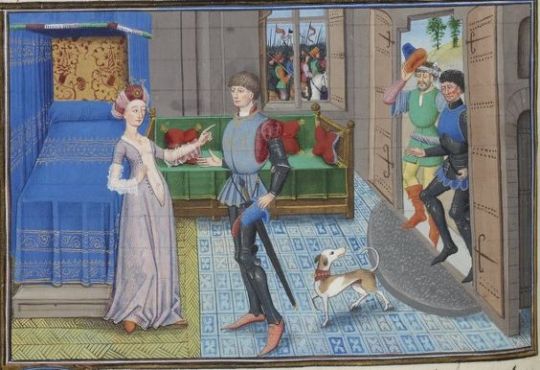
Maugis of Aigremont and Isanne in the Queen's Bedroom (15th Century) by Loyset Liédet
sources: https://gallica.bnf.fr/ark:/12148/btv1b8426778v/f270.item
https://en.wikipedia.org/wiki/Loyset_Li%C3%A9det
https://en.wikipedia.org/wiki/The_Four_Sons_of_Aymon#Dutch_version
Loyset Liédet was an early Netherlandish miniaturist and illuminator. He was very successful and patronized by many of the leading collectors of his day but today he is scarse heard of.
Liédet illustrated and painted for the Medieval manuscript of The Four Sons of Aymon, sometimes also referred to as Renaud de Montauban. It is a medieval tale spun around the four sons of Duke Aymon , his brothers Guichard, Allard and Richardet, their magical horse Bayard and their adventures and revolt against the emperor Charlemagne.
In this painting, the furniture and objects are depicted not as a central focus but instead are secondary to the human drama taking place. You can tell that the owner of this room is wealthy because of the elaborate patterns on the fabrics and the floors.
There is little volume in this piece and the painting is incredibly flat. Some of the proportions and the foreshortening are completely off such as the bed and the angle of the door. This is probably due to a lack of understanding at the time of shading and maths coming together to create a realistic illusion of depth.
The doors and windows in this painting play a critical role in the narrative. Some men have come to visit the queen at her door and the space behind them seems peaceful and expansive. However, very close by through the window we can see what appears to be an army of men marching past. This leads us to question the narrative and it foreshadows a treacherous event to come.
I personally think this is an excellent painting for its purpose as an illustration in a manuscript. It has a clear narrative and shows the progression of the story in a creative way. The setting and colours in this painting clearly illustrate the wealth of the queen and also the time period it is set in.

Just what was it that made yesterday’s homes so different, so appealing? (1956) by Richard Hamilton
Sources: Art Since 1900 Modernism Antimodernism Postmodernism published by Thames & Hudson
https://www.tate.org.uk/art/artworks/hamilton-just-what-was-it-that-made-yesterdays-homes-so-different-so-appealing-upgrade-p20271
http://www.bbc.com/culture/story/20150824-richard-hamilton-and-the-work-that-created-pop-art
This piece is a collage designed by Hamilton not as an art object but to reproduce as a poster and in a catalogue. It is a pop-physiological parody of postwar consumer culture made with its own ad-slogans and image-bits.
This collage features two contempories of the time depicted as being narcissistic. They are connected only by the lollipop which acts as a phallic symbol and points towards the woman’s breasts and the commodities positioned in the room around them.
A woman speaking on the telephone is on the TV and there is a poster for romance on the wall. An advert for a cleanign service comes to life on the stairs and the extra long hose reinforces the theme of ‘comodity-appliance-as-phallus.’
There is an abundance of ‘the woman’ in this collage and she seems to rule this appartment but it is implied that she too is a commodity. Although she may fantasize about the body builder, there is a portrait of a patriarch on the wall looking over her and the man of the house is implied missing by thr newspaper on the armchair.
This interior is completely overtaken by the outside world. There are hints of media through the TV, radio, advertisements and posters which test boundaries between public and private and the window indicates the room is wide open to influence from the outside world.
The imagery we associate with pop art is often American celebrities and consumer goods but pop art in fact came about in Britain from the Independant Group lead by Richard Hamilton who is now known as the progeitor of British pop. As Alastair Stooke comments as an art critic of The Daily Telegraph, “Hamilton’s collage is often described as the first work of Pop Art, perhaps even its manifesto.”
This type of college art is something that particularly intersts me. I have a fascination with the 1950′s and their lifestyle and culture in Britain and America. This collage combines these factors to present a rosy but cynical look at post-war life and I think it is successful at portraying its obserdity.

Prince (2010) by Gillian Carnegie
Sources: Colin Perry, Vitamin P2 published by Phaidon p.72
http://www.andrearosengallery.com/exhibitions/gillian-carnegie/7
Gillian Carnegie often paints in a dull pallette of greens and greys which tend to make her work appear old-fashioned. In her paintings she often paints the same motifs which can include a black cat, a vase of wilting flowers and a staircase, two of which are featured in the painting above.
Her subtle tones speak of a high contrast with mainstream media and modern art which is so full of colour and eye-catching vibrancy. As Perry says, “her works are particularly sophisticated in their ability to destabilise icons of macho modernism, whose fierce denial of representative content has been questioned since the 1970′s.” Modernism is a genre that rushed ahead of itself but Carnegie takes a slower and more relaxed approach.
Her paintings main focus is the suggestion of inhabiting space and with her use of vertical arrangements of line and form she suggests an urban environment that has been compressed. Despite the claustrophobic atmosphere, she does not imply a sense of busy city life, but rather a feeling of calm.
Her paintings could be read as arguments in favour of a way of living in a busy city yet heading towards enjoyment of space free from modern chaos as suggested by Perry.
Looking at Prince instantly gives me a feeling of relaxation and calm. The colours speak to me in a way I cannot explain which bring me into a place of rest. The title of this painting to me suggests that the main focus of this painting, the cat, rules over the stairway and is comfortable and pampered in his own space. A lack of windows or doors in this painting suggests to me that this is a comfortable environment, free from threat and devoid of destructive behaviour.
There is a lack of human drama in this painting which utters a sense of calm although the cat turns its head as if stirring to a noise somewhere else in the house. Although the foucs is on a very small space, having stairs in the composition hints at a larger, perhaps more busy place away from this cat’s safe, quiet space.
#mieris#art#paint#painting#genre#dutch#interiors#maes#vermeer#loyset liedet#richard hamilton#collage#gillian carnegie
0 notes
Photo
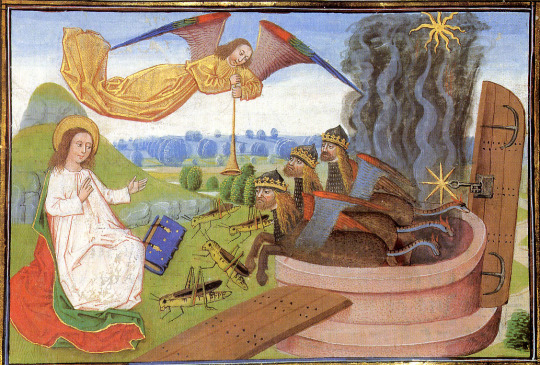
Loyset Liédet and his workshop - Epistolary and Apocalypse of Charles the Bold - Belgium, Bruges, ca. 1470
Loyset Liédet (1420 – after 1479, or after 1484), was an early Netherlandish miniaturist and illuminator, running a workshop which may have been of some size. Although he was very successful, and patronized by the leading collectors of his day, his work does not attain the standards of his finest Flemish contemporaries, with whom he often collaborated on large commissions.
Liédet was a prolific artist coming from Hesdin in Artois. Between 1454 and 1460 he worked in Hesdin where he produced 55 thumbnails for La Fleur des Histoires by Jean Mansel, commissioned by Philip the Good of the House of Valois-Burgundy. He illustrated Royal Library of Belgium MS 9967, a copy of Jehan Wauquelin's edition of La Belle Hélène de Constantinople for Philip.
He also did some work for Charles the Bold. In his early work, he was influenced by Simon Marmion. After 1467 he was found in Bruges, where he was a member of the Guild of Saint Luke listed as an illuminator. In all probability he continued to work in Bruges until 1479. Liédet was long thought to have died around 1479, the date of the last mention of him in the archives of Bruges. However recent research by Dominique Vanwijnsberghe in the archives of Lille shows that Liédet and his brother Huchon (or Husson) were still listed in the archives of that city in 1483 and 1484.
69 notes
·
View notes
Photo

Loyset Liédet (Flemish, active about 1448 - 1478) - The Byzantine Emperor Welcoming Roussillon and Martel
written 1463 - 1465; illuminated 1467 - 1472
Tempera colors, gold leaf, and gold paint on parchment
The J. Paul Getty Museum, Los Angeles
#loyset liédet#byzance#art#flemish art#aesthetic#manuscript#Illustration#illuminator#Getty Museum#netherlands#holland#belgium#belgian art#book#writing#calligraphy#renaissance#renaissance art#early flemish painting#los angeles#beaux arts#tempera colors#parchment#15th century#The Byzantine Emperor#flandres#Flanders#castle#emperor#roussillon
80 notes
·
View notes